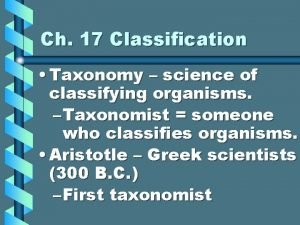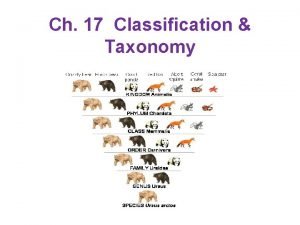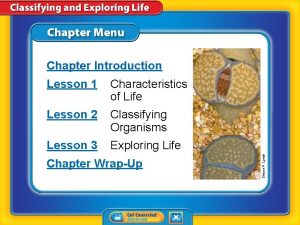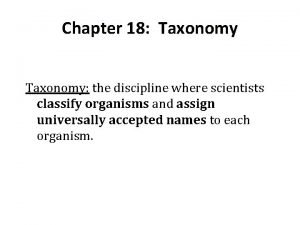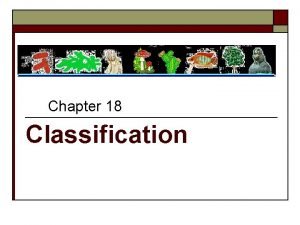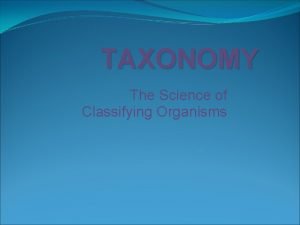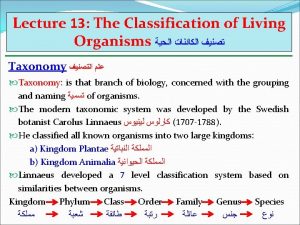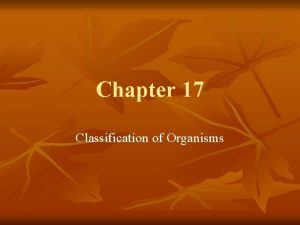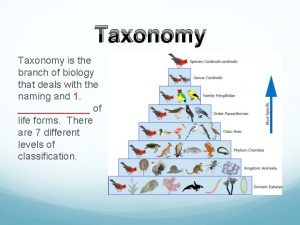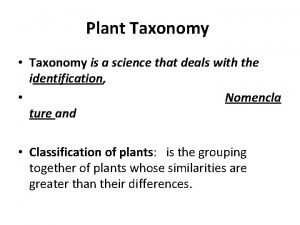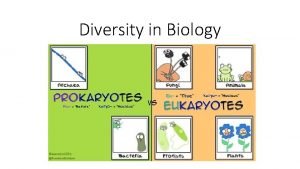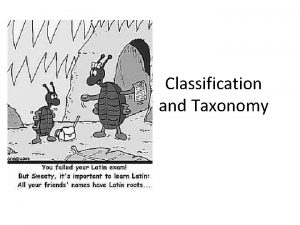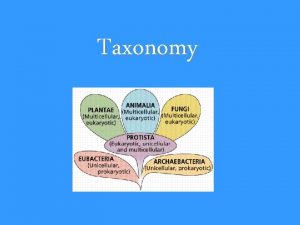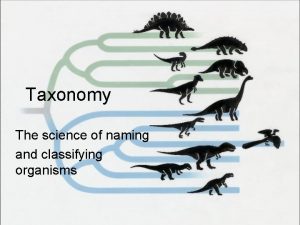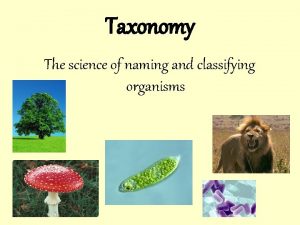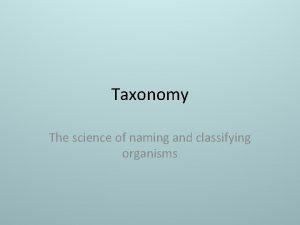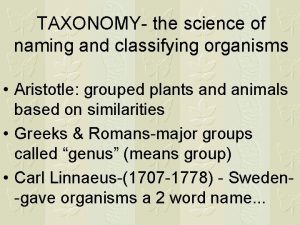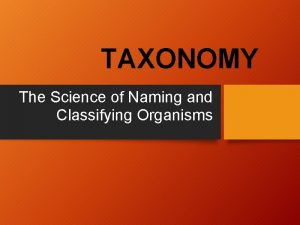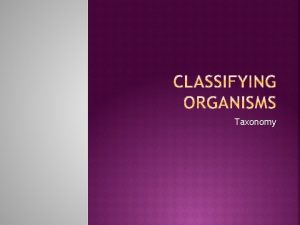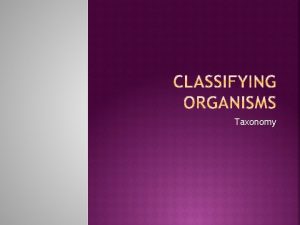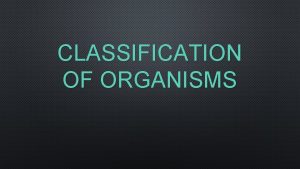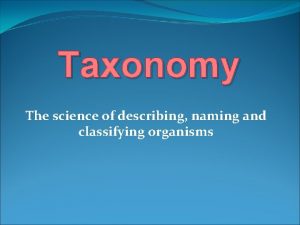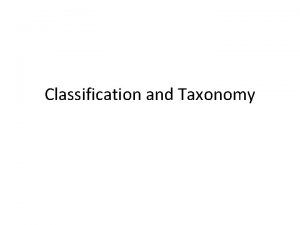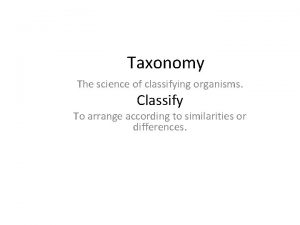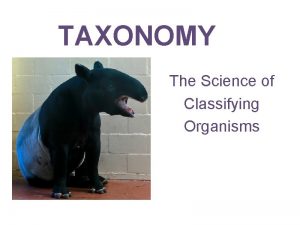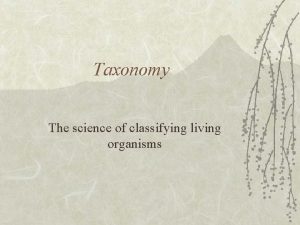Taxonomy Science of Classifying Naming Organisms Taxonomist l






























- Slides: 30

Taxonomy Science of Classifying & Naming Organisms

Taxonomist l scientist who practices the art of classifying organisms

Classification l The grouping of objects or information based on similarities

Systems of Classification An historic view

1. Aristotle 1. 2. 3. 4. 5. Greek Philosopher Developed the first method of classification Two Kingdom System I. e. : Plants and animals Did not show the natural relationships among organisms

Aristotle 5. Plants l Trees l Shrubs l Herbs

Aristotle 6. Animals l Air l Land l Water

Middle Ages 1. Scientists started using Latin for naming organisms 2. Why? Language of scholars, universal, dead

Middle Ages Examples: 1. Canis = 2. Felis = 3. Equis =

Classmate Polynomials l l l Develop a polynomial to describe yourself. You can use physical characteristics/traits, behavioral characteristics (things you do), interests. Your polynomial must contain 6+ words. Much to the dismay of Middle Age Scientists, I’ll let you write in English!

3. Carolus Linnaeus Binomial Nomenclature l l l “Modern” system – every species has a two word Latin name Developed by Carolus Linneaus (Carl von Linne) ie. Genus + descriptive word

3. Carolus Linnaeus Binomial Nomenclature Scientific name = genus + descriptive word

3. Carolus Linnaeus Binomial Nomenclature l Example #1 Homo sapiens Homo = sapiens =

3. Carolus Linnaeus Binomial Nomenclature Example #2 and #3 Quercus alba and Quercus rubra Quercus = alba = rubra =

Be Mindful! Other species may have the same descriptive term. ex. Betta rubra (red betta fish) Myrmica rubra (Common red ant)

Rules for Writing a Scientific Name Homo sapiens or Homo sapiens 1. Name is underlined or italicized 2. First word (genus) is capitalized, second word (descriptive) is lower-case 3. Abbreviation = H. sapiens or H. sapiens

Notable Names 1. 2. 3. 4. Abra cadabra (clam) Agra vation (caribid beetle…nothing aggravating @ it!) Dissup irae (hard to see fossil fly) Cyclocephala nodanotherwon (scarab beetle discovered by a scientist named Ratcliffe) Curiosities of Biological Nomenclature by Mark Isaak, http: //www. curioustaxonomy. net/puns. html. . . link on Edline

Biological Hierarchy of Classification for the Honey Bee Domain = Kingdom = Phylum = Class = Order = Family = Genus = Species = http: //en. wikipedia. org/wiki/Honeybee

Biological Hierarchy of Classification for a Human Being Domain = Kingdom = Phylum = Class = Order = Family = Genus = Species = http: //anthro. palomar. edu/animal/table_ humans. htm

Mneumonic for Human Classification by Emily Theobald l Every Adorable Cat Makes People Have Heart “Hattacks”!



Three Domain System of Classification l l l Three domains- Archea, Bacteria and Eukarya Archea-archeabacteria Bacteria-Eubacteria Eukarya-”Eukaryotic” organisms-kingdoms Protista, Fungi, Plantae, Animalia Form of classification based on an evolutionary model comparing RNA found in cells & cell membrane structure

Three Domain Classification Scheme

Biological Hierarchy of Classification Domain= Kingdom = Phylum = agroup of closely related classes (called divisions in plants) Class = Order = Family = Genus = a group of closely related species Species = a group of organisms that can reproduce successfully with each other



How Relationships are Determined l 1. 2. 3. 4. Four things: Similarities in structure DNA Behavior Evolutionary relationships

What is the complete classification of the following organisms: A. Fox B. Frog C. Squirrel D. Lion

 Genus order family
Genus order family Canis latrans classification
Canis latrans classification In the hierarchy of classification which grouping
In the hierarchy of classification which grouping Fungi cell
Fungi cell Discipline of classifying and naming organisms
Discipline of classifying and naming organisms Discipline of classifying and naming organisms
Discipline of classifying and naming organisms Liger taxonomy
Liger taxonomy Lesson 1 characteristics of life answer key
Lesson 1 characteristics of life answer key Classifying organisms worksheet
Classifying organisms worksheet Lesson outline classifying organisms
Lesson outline classifying organisms Lesson 2 classifying organisms
Lesson 2 classifying organisms Why do scientists classify organisms?
Why do scientists classify organisms? Kingdom animalia cladogram
Kingdom animalia cladogram Most general to most specific classification
Most general to most specific classification Domain kingdom phylum mnemonic
Domain kingdom phylum mnemonic Kendall and marzano's new taxonomy
Kendall and marzano's new taxonomy Dear king phillip came over
Dear king phillip came over Levels of classification
Levels of classification 8 major levels of classification
8 major levels of classification Biology
Biology Competitive interaction
Competitive interaction Organisms
Organisms My favorite subject is art
My favorite subject is art Science manipulative skills
Science manipulative skills Science process skills definition
Science process skills definition Taxonomy is the branch of science that deals with –
Taxonomy is the branch of science that deals with – Study of plants
Study of plants Taxonomy is the branch of science that deals with
Taxonomy is the branch of science that deals with Taxonomy is the science that deals with
Taxonomy is the science that deals with Taxonomy is the science that deals with
Taxonomy is the science that deals with Social science vs natural science
Social science vs natural science





